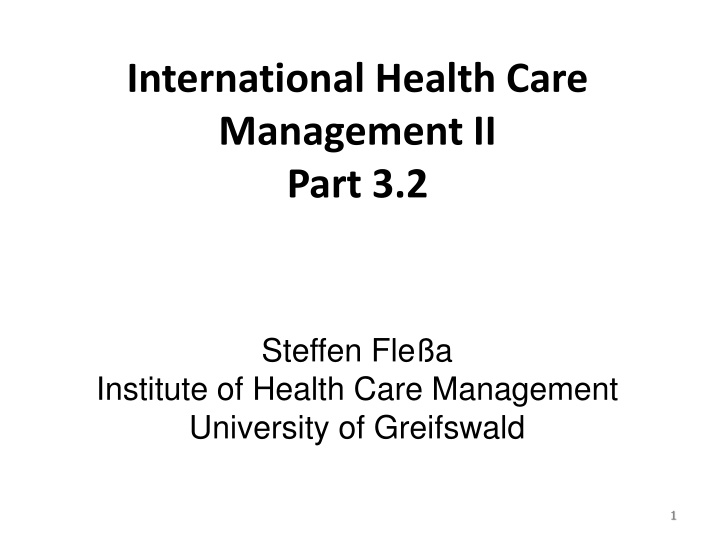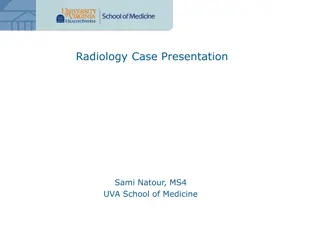
Understand Options of Funding and Demand for Health Insurance
Learn about health care management, reforms, and the various factors influencing funding options and demand for health insurance, including age, quality, accessibility, and willingness to pay.
Download Presentation

Please find below an Image/Link to download the presentation.
The content on the website is provided AS IS for your information and personal use only. It may not be sold, licensed, or shared on other websites without obtaining consent from the author. If you encounter any issues during the download, it is possible that the publisher has removed the file from their server.
You are allowed to download the files provided on this website for personal or commercial use, subject to the condition that they are used lawfully. All files are the property of their respective owners.
The content on the website is provided AS IS for your information and personal use only. It may not be sold, licensed, or shared on other websites without obtaining consent from the author.
E N D
Presentation Transcript
International Health Care Management II Part 3.2 Steffen Fle a Institute of Health Care Management University of Greifswald 1
Health Care Reform: Structure 1. Demand for Health Services 2. Supply of Health Services 1. Factors of Production 1. Buildings and Equipment 2. Staff 3. Problems of Donations 2. Spatial Structure of Supply 3. Levels of Care 4. Provider Portfolio 3. Health Care Reforms 1. Costs 2. Options of Funding 3. Health Care Systems by International Comparison 2
3.2 Options of Funding POPULATION DONORS GOVERNMENT HEALTH SERVICES SOCIAL HEALTH INSURANCE PRIVATE HEALTH INSURANCE Direct Input HEALTH CARE FACILITIES 3
Demand for an Insurance Age Quantity Objective quality Subjective quality Distance + + + Chronic illness Family illnesses Danger location Danger profession + + + Health Care Services Accessible Risk of illness - + + + + Risk of health care expenditure Household income Wealth Other sources (e.g. HEF, family) - - + - Risk of catastrophic h.c. expenditure Time preference - 4
Demand for an Insurance + Risk of catastrophic h.c. expenditure Time preference Risk aversion - + + Household structure, e.g. gender of household head Other priorities Perception of risk of catastro. h.c.exp. + Willingness to Pay + 5
Demand for an Insurance Other sources (e.g. Mode of collection Household income HEF, family) Premium Wealth Accessibility of Insurance Willingness to Pay - + + + Ability to Pay + + - - - - Demand for Insurance + Distance Knowledge Friendliness Culturally acceptable 6
Age Quantity Objective quality Subjective quality Distance + + + Chronic illness Family illnesses Danger location Danger profession + + + Health Care Services Accessible Risk of illness - + + + + Risk of health care expenditure Household income Wealth Other sources (e.g. HEF, family) - - Demand for an Insurance + - Risk of catastrophic h.c. expenditure Time preference Risk aversion - + + Household structure, e.g. gender of household head Other priorities Perception of risk of catastro. h.c.exp. Other sources (e.g. Mode of collection Household income HEF, family) Premium Wealth + Accessibility of Insurance Willingness to Pay - + + + Ability to Pay + + - - - - Demand for Insurance + Distance Knowledge Friendliness Culturally acceptable 7
Health Care Financing Alternatives Variable Alternative 1 Community- based Alternative 2 Alternative 3 Beveridge System Alternative 4 Private for- profit Insurance system Social insurance Part of national administration Parastatal organisation Administration Private Public Legal form of ownership Parastatal Corporation Administration Number of insurances Monopoly Oligopoly Polypoly Outpatient Prevention/ promotion Inpatient Curative medicine Services covered Rehabilitation Long-term care Entire population Target group Insured Family Social insurance Ceiling No ceiling Cost covered Co-payment No Co-payment Limited list of conditions Exclusion of conditions 8 Conditions covered no exclusions
Health Care Financing Alternatives Variable Alternative 1 Alternative 2 Alternative 3 Alternative 4 Principle form of financing Earmarked taxes (e.g. tobacco) payroll contribution General tax other premium Revenues collection by Tax collection Own agents Separate agency employers Event (e.g. show-up in hospital) Time of revenue collection Monthly Yearly Revenues, means of payment Cash In kind Free-of-charge, not appl. Subsidized premium Full-cost premium Subsidy for vulnerables Premium Premium proportional to Income-based Wealth-based Risk-based Capitation Exemptions Vulnerables not applicable 9
Health Care Financing Alternatives Variable Alternative 1 Alternative 2 Alternative 3 Alternative 4 National risk pool Provincial risk pool Pooling of Risks Smaller pools Re-insurance Actuarial accounting / premium calculation No actuarial accounting Actuarial accounting Administration/ Accounting Health Facility IT Patient files tele-medicine Insurance IT Member files claims settling Administration other transfer manually integrated platform full integration incl. MoH IT integration Entire population Civil servants ... other Target group Work force Vulnerables Registration of new clients Own offices / agents Third-party agents At point of service Only online 10
Health Care Financing Alternatives Variable Alternative 1 Alternative 2 Alternative 3 Alternative 4 Not in case of illness Start of employment Time of registration Every day Certain times Own customer office(r)s No customer relations Health facility staff Customer relations Online only Insurance and health facility are one (HMO) Relation to health facility Separate institutions actual marginal cost Rebates based on actual full cost estimates political prices Rebates outpatient care fee-for-service capitation budgets mixed flat rates / DRGsbudgets/capitati Rebates inpatient care fee-for-service daily rates on part is fixed budget Budget rebates only 11
Health Care Financing Alternatives Variable Alternative 1 Alternative 2 Alternative 3 Alternative 4 Insurance requires from health facility No quality management Country-wide QM International QM Management support Management support Training no support Insurance provides to health facility Other support Quality Management insurance National standard International standard No QM Own QM system Personnel department Part of public admin. No separate department Staffing Selection of staff based on Professionalism Kinship Official rank Other 12
Health Care Financing Alternatives Variable Alternative 1 Alternative 2 Alternative 3 Alternative 4 Leadership of professionals No professional managers Leading and Directing Off-the-job training On-the-job training Academic training Staff development Strategy, Control and Change Management Service portfolio management Strategic cooperation Strategic Resources 13
Concepts of Remuneration HEALTH FUNDING Input-basierte Finanzierung Output-basierte Finanzierung Output-based Aid Needs Output-based funding Input-based funding Combined funding based on based on Admissions Buildings Lump Sum Funding Patient Days Population Equipment Lump Sums Beds Materials Nursing Rates / DRGs Services Staff Other 14
Input-Based Funding Provider Client Service Fixed Budget Funding Entity (Health Insurer, Government) 15
Input-Based Funding: Ways MINISTRY of HEALTH (MoH) HEALTH INSURANCE REGION FINANCIAL SERVICE PROVIDER DISTRICT ASSOCIATIONS SERVICE PROVIDER 16
Output-Based Funding Proof of Authorization Provider Client Service Proof of Authorization Reimbursement Bill Funding Entity (Health Insurance, Government) 17
Output-Based Aid Voucher Voucher Service Provider Client service pays Voucher Reimburse- ment Claim Distributor Voucher Voucher Management Agency 18
Example: Kenya As of June 2006 for Family planning Delivery Gender Violence Recovery (GVR) Cost (here: delivery) Voucher: 200 Ksh Reimbursement Normal delivery: (incl. 4 ante-natal): 5000 Ksh C-Section: 20,000 Ksh 19
600000 40000000 35000000 500000 Subsidies (Births) 30000000 Amount of Vouchers p.a. Subsidy p.a. [US$] 400000 25000000 300000 20000000 15000000 200000 10000000 100000 5000000 0 0 0 10 20 30 40 Poverty [% of population] 20 Amount of Vouchers p.a. Subsidy p.a. [US$]
Health Care Reform: Structure 1. Demand for Health Services 2. Supply of Health Services 1. Factors of Production 1. Buildings and Equipment 2. Staff 3. Problems of Donations 2. Spatial Structure of Supply 3. Levels of Care 4. Provider Portfolio 3. Health Care Reforms 1. Costs 2. Options of Funding 3. Health Care Systems by International Comparison 21




